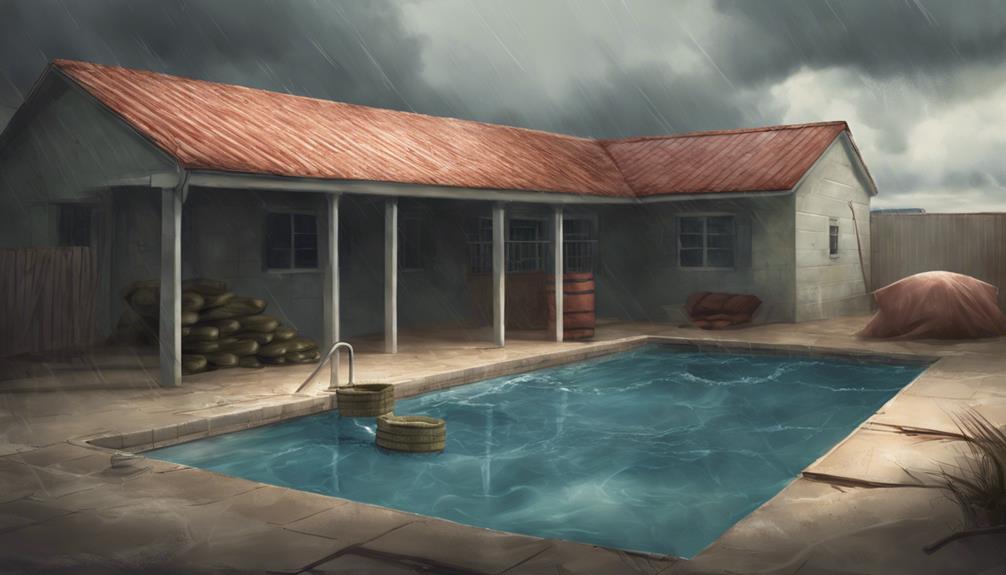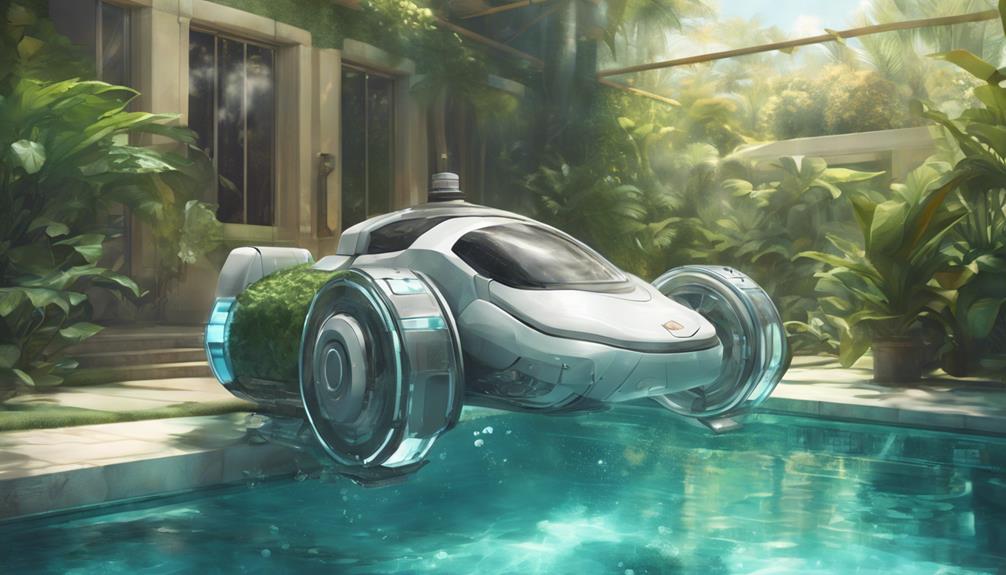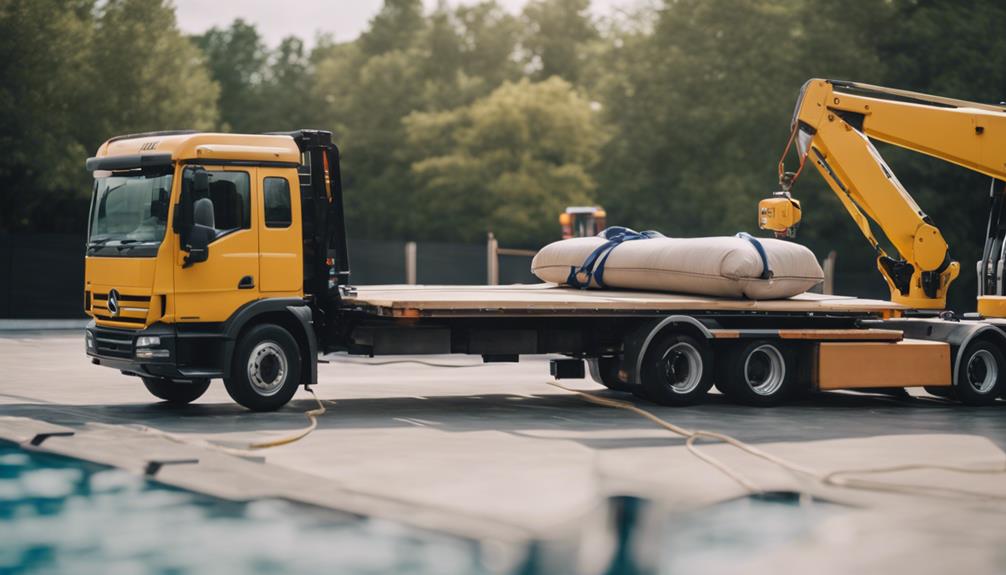Protect your pool from storms by taking the necessary precautions such as removing pool covers that are not designed for heavy debris, securing loose accessories like umbrellas, and turning off all pool systems to prevent damage. Do not drain the pool; instead, use algaecide to prevent algae growth from rainwater. These important steps will help maintain your pool’s integrity and functionality during inclement weather.
Key Takeaways
- Remove pool covers to prevent damage and store indoors.
- Secure loose accessories to prevent projectiles in high winds.
- Turn off pool systems to avoid electrical and gas issues.
- Avoid draining pool to maintain structural integrity.
- Use algaecide to prevent algae growth from rainwater and debris.
Pool Cover Removal
When preparing your pool for an upcoming storm, the first crucial step is removing the pool cover to safeguard it from potential damage. While pool covers are effective at protecting against leaves, bugs, and sun damage, they are not designed to withstand heavy debris, rain, and winds that accompany storms.
By taking off the pool cover, you can prevent it from getting damaged and guarantee it remains intact for future use. It is advisable to store the pool cover in a plastic tote indoors to keep it safe and ready for deployment once the storm passes.
For automatic pool covers, securely covering them with tarps can provide an additional layer of protection against storm damage.
Secure Loose Accessories
To prevent potential damage during storms, it is essential to secure any loose accessories and furniture around the pool area. In high winds, pool accessories can easily become projectiles, causing harm to both the items themselves and the pool structure.
To avoid this, store all loose accessories indoors or tie them down securely with a tarp. This proactive measure not only prevents damage but also saves time that would otherwise be spent collecting scattered items post-storm.
Make sure to particularly secure umbrellas, chairs, tables, and grills, as these items are prone to being blown away. By taking these precautions, you can minimize the risk of damage to your pool area and its surroundings.
Turn Off Pool Systems

Securing loose accessories around the pool area is a proactive step in storm preparation. Similarly, turning off pool systems is essential to protecting pool equipment during severe weather events.
To properly prepare your pool for a storm, follow these steps:
- Shut off or remove electric pumps, filtration systems, and lighting to prevent damage from heavy flooding and falling debris.
- Remember to turn off gas and electric systems to safeguard safety and prevent accidents.
- Store solar heaters indoors to shield them from damage caused by severe weather.
- Take precautions to avoid potential motor damage and short circuits that could arise during a storm.
Avoid Draining Pool
Preventing potential structural damage and maintaining system health, avoiding draining the pool is essential before a storm. Draining the pool can cause structural damage due to groundwater pressure. It is advisable to lower the water level to prevent overflowing but keep it above the skimmer level. Using a submersible pump or pool vacuum to achieve this maintains the pool's structural integrity and system health. This crucial step prevents potential damage during heavy rain.
| Avoid Draining Pool | |
|---|---|
| Benefits | How to Achieve |
| Prevents structural damage | Lower water level above skimmer |
| Maintains system health | Use submersible pump or pool vacuum |
Preparing With Algaecide

Adding algaecide to the pool water before a storm can effectively prevent algae growth caused by rainwater and debris contamination. Rainwater dilutes pool chemicals, making algae stronger and leading to unsightly algae blooms. By proactively treating the pool with algaecide, you can save time and effort on post-storm cleanup and chemical rebalancing.
Here are four essential steps to prepare your pool with algaecide:
- Choose a quality algaecide recommended for your pool type.
- Follow the manufacturer's instructions for proper dosage.
- Distribute the algaecide evenly across the pool water.
- Run the pool pump for efficient circulation and algaecide distribution.
Frequently Asked Questions
Can I Use a Regular Tarp Instead of Storing the Pool Cover Indoors?
It's advisable to store the pool cover indoors rather than using a regular tarp. Storing the cover indoors protects it from damage during storms, ensuring its longevity. A tarp may not provide adequate protection and could lead to cover deterioration.
Should I Tie Down Inflatable Pool Toys During a Storm?
Just as a ship secures its cargo for a storm, tie down inflatable pool toys during inclement weather. Prevent them from becoming airborne hazards, causing damage or injury. Safeguard property and guarantee a smoother post-storm cleanup.
Can I Leave Patio Furniture in the Pool During a Storm?
During a storm, it is not advisable to leave patio furniture in the pool. Loose items can damage both the furniture and the pool. Securely store or tie down furniture to prevent potential hazards and guarantee safety.
Is It Necessary to Turn off Pool Lighting Before a Storm?
Before a storm, it is crucial to turn off pool lighting to prevent electrical damage. Water can cause short circuits, endangering swimmers and damaging equipment. Safeguard your pool by disconnecting lighting systems during storms.
Can I Add Algaecide During Heavy Rain to Prevent Algae Growth?
Adding algaecide during heavy rain is not recommended as rainwater dilutes pool chemicals, weakening their effectiveness. It is best to add algaecide before the storm to prevent algae growth, ensuring a clean pool post-storm.
How Can I Prepare My Pool for Winter Storms and Snow?
Before winter storms hit, implement pool snow survival strategies. Lower the water level to avoid damage from freezing. Cover the pool to prevent debris and ice accumulation. Use a pool antifreeze solution to protect the plumbing. Clear snow promptly to avoid heavy weight on the cover.
What Essential Preparations Should I Make to Ensure Safety and Value of My Pool During a Storm?
When preparing for a storm, remember to include pool safety inspection essentials in your checklist. Secure loose items around the pool area, such as furniture and toys, to prevent them from becoming projectiles in high winds. Ensure your pool cover is properly secured to prevent debris from entering the pool and causing damage.
What Preparations Can Help Prevent Pool Overflow During a Storm?
When facing the threat of a storm, taking proactive measures is key to avoiding pool water disaster solutions. Clearing the pool area of any debris and lowering the water level can help prevent overflow. Installing a proper drainage system and securing pool covers are also effective preparations.
Conclusion
To sum up, ensuring your pool is properly prepared for impending storms is essential to prevent damage and maintain its integrity.
While some may argue that storm-proofing measures are time-consuming and unnecessary, the potential costly repairs that can result from neglecting these precautions far outweigh the initial effort.
By taking proactive steps to secure your pool and its systems, you can protect your investment and enjoy a safe and functional pool even in the face of adverse weather conditions.









